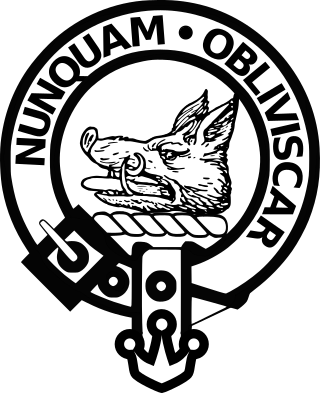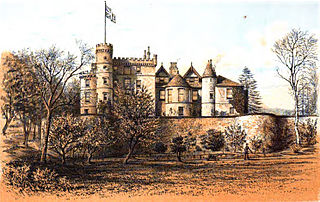
Clan Campbell is a Highland Scottish clan, historically one of the largest and most powerful of the Highland clans. The Clan Campbell lands are in Argyll and within their lands lies Ben Cruachan. The chief of the clan became Earl of Argyll and later Duke of Argyll.

The West Highland White Terrier, commonly known as the Westie, is a breed of dog from Scotland with a distinctive white harsh coat with a somewhat soft white undercoat. It is a medium-sized terrier, although with longer legs than other Scottish breeds of terrier. It has a white double coat of fur which fills out the dog's face, giving it a rounded appearance.

Clan MacLeod is a Highland Scottish clan associated with the Isle of Skye. There are two main branches of the clan: the MacLeods of Harris and Dunvegan, whose chief is MacLeod of MacLeod, who are known in Gaelic as Sìol Tormoid ; the Clan MacLeod of Lewis and Raasay, whose chief is MacLeod of The Lewes, are known in Gaelic as Sìol Torcaill. Both branches claim descent from Leòd, a Norse-Gael who lived in the 13th century.

Clan MacNeil, also known in Scotland as Clan Niall, is a highland Scottish clan of Irish origin. According to their early genealogies and some sources they're descended from Eógan mac Néill and Niall of the Nine Hostages. The clan is particularly associated with the Outer Hebridean island of Barra. The early history of Clan MacNeil is obscure, however despite this the clan claims to descend from the legendary Irish King Niall of the Nine Hostages, who is counted as the 1st Clan Chief, the current Clan Chief being the 47th. The clan itself takes its name from a Niall who lived in the 13th or early 14th century, and who belonged to the same dynastic family of Cowal and Knapdale as the ancestors of the Lamonts, MacEwens of Otter, Maclachlans, and the MacSweens. While the clan is centred in Barra in the Outer Hebrides, there is a branch of the clan in Argyll (McNeill/MacNeill) that some historians have speculated was more senior in line, or possibly even unrelated. However, according to Scots law the current chief of Clan MacNeil is the chief of all MacNeil(l)s.

Sir Ian Zachary Malcolm, 17th Laird of Poltalloch, KCMG was a Conservative Member of Parliament and Chieftain of the Clan Malcolm/MacCallum.

Clan Maclean is a Highlands Scottish clan. They are one of the oldest clans in the Highlands and owned large tracts of land in Argyll as well as the Inner Hebrides. Many early MacLeans became famous for their honour, strength and courage in battle. They were involved in clan skirmishes with the Mackinnons, Camerons, MacDonalds and Campbells, as well as all of the Jacobite risings.

Clan MacDougall is a Highland Scottish clan, historically based in and around Argyll. The Lord Lyon King of Arms, the Scottish official with responsibility for regulating heraldry in Scotland, issuing new grants of coats of arms, and serving as the judge of the Court of the Lord Lyon, recognizes under Scottish law the Chief of Clan MacDougall. The MacDougall chiefs share a common ancestry with the chiefs of Clan Donald in descent from Somerled of the 12th century. In the 13th century the Clan MacDougall whose chiefs were the original Lords of Argyll and later Lords of Lorne was the most powerful clan in the Western Highlands. During the Wars of Scottish Independence the MacDougalls sided with the Clan Comyn whose chiefs rivaled Robert the Bruce for the Scottish Crown and this resulted in clan battles between the MacDougalls and Bruce. This marked the MacDougall's fall from power and led to the rise of their relatives, the Clan Donald, who had supported Bruce and also the rise to power of the Clan Campbell who were then the habitual enemies of the MacDougalls and later of Clan Donald.

Duntrune Castle is located on the north side of Loch Crinan and across from the village of Crinan in Argyll, Scotland. It is thought to be the oldest continuously occupied castle on mainland Scotland. The castle is a category B listed building.

Carnasserie Castle is a ruined 16th-century tower house, noted for its unusual plan and renaissance detailing. It is located around 2 kilometres north of Kilmartin, in Argyll and Bute, western Scotland, at grid reference NM837009.

Clan Lamont is a Highland Scottish clan. The clan is said to descend from Ánrothán Ua Néill, an Irish prince of the O'Neill dynasty, and through him Niall Noigíallach, High King of Ireland. Clan Ewen of Otter, Clan MacNeil of Barra, Clan Lachlan, and Clan Sweeney are also descendants of Ánrothán. Traditional genealogy would therefore include Clan Lamont among the descendants of Conn Cétchathach.

Clan Maclachlan, also known as Clan Lachlan, Clann Lachainn (Argyll), and Clann Lachlainn, is a Highland Scottish clan that historically centred on the lands of Strathlachlan on Loch Fyne, Argyll on the west coast of Scotland. The clan claims descent from Lachlan Mor, who lived on Loch Fyne in the 13th century, and who has left his name upon the countryside he once controlled: places such as Strathlachlan, Castle Lachlan and Lachlan Bay. Tradition gives Lachlan Mor a descent from an Irish prince of the O'Neill dynasty, Ánrothán Ua Néill, son of Áed, son of Flaithbertach Ua Néill, King of Ailech and Cenél nEógain, died 1036. Clan Maclachlan has been associated with other clans, such as Clan Lamont, Clan Ewen of Otter, Clan MacNeil of Barra, and the MacSweens: as all claim descent from Anrothan O'Neill who left Ireland for Kintyre in the 11th century. From this descent the clan claims a further descent from the legendary Niall Noigíallach, High King of Ireland, who lived from the mid 4th century to the early 5th century.

Clan MacAlister is a Scottish Clan. The clan is the earliest branch to have split off from Clan Donald, claiming descent from Alasdair Mòr, son of Domhnall founder of Clan Donald. From Alasdair Mòr the clans takes its surname MacAlister; this surname is an Anglicisation of the Gaelic MacAlasdair meaning "son of Alasdair". In the 15th century the chief of the clan was seated in Kintyre, and the clan was centred there until the 18th century, when a chief sold the family estate in preference to an estate in the Scottish Lowlands.

Clan Macfie is a Highlands Scottish Clan.

Clan MacAulay, also spelt Macaulay or Macauley is a Scottish clan. The clan was historically centred on the lands of Ardincaple, which are today consumed by the little village of Rhu and burgh of Helensburgh in Argyll and Bute. The MacAulays of Ardincaple were located mainly in the traditional county of Dunbartonshire, which straddles the "Highland Line" between the Scottish Highlands and Lowlands. Clan MacAulay has been considered a "Highland clan" by writers and has been linked by various historians to the original Earls of Lennox and in later times to Clan Gregor. The MacAulays of Ardincaple, like Clan Gregor and several other clans, have traditionally been considered one of the seven clans which make up Siol Alpin. This group of clans were said to have claimed descent from Cináed mac Ailpín, King of the Picts, from whom later kings of Scotland traced their descent. The chiefs of Clan MacAulay were styled Laird of Ardincaple.

Clan MacIver or Clan MacIvor, also known as Clan Iver, is a Scottish clan recognised by the Lord Lyon King of Arms. The clan, however, does not have a chief recognised by the Lord Lyon King of Arms. Because of this the clan can be considered an armigerous clan. The clan name of MacIver is of Gaelic origin, derived from an Old Norse personal name. Various forms of the surname MacIver, like MacGiver, are considered sept names of several historically large Scottish clans, such as clans Campbell and Mackenzie. There exists a Clan Iver society in Fife, Scotland.

Ardencaple Castle, also known as Ardincaple Castle, and sometimes referred to as Ardencaple Castle Light, is a listed building, situated about 1 statute mile (1.6 km) from Helensburgh, Argyll and Bute, Scotland. Today, all that remains of the castle is a tower, perched on the edge of a plateau, looking down on a flat tract of land between it and the shore of the Firth of Clyde. The original castle was thought to have been built sometime in the 12th century, and part of the remains of the original castle were said to have existed in the 19th century. Today, that sole remaining tower is used as a navigational aid for shipping on the Firth of Clyde. Because of its use as a lighthouse the tower has been called Ardencaple Castle Light.

Sir Aulay MacAulay of Ardincaple was a Scottish laird, knight, clan chief, and a shire commissioner. He was the son and heir of Walter MacAulay Ardincaple, who was the laird of Ardincaple and chief of Clan MacAulay. The MacAulay estate of Ardincaple was situated in the location of the modern village of Rhu and Helensburgh, which both lie on the eastern shore of the Gare Loch, in Argyll and Bute. As chief of his clan, he entered into a contract with the chief of the MacGregors, pledging service and assistance to their chief. His clan feuded with the Buchanans, and his marriage to the widow of a deceased Galbraith chief brought forth feuding with that clan. He also feuded with the Campbells, particularly the Captain of Carrick. The Campbells made several attempts on his life and he was wounded one such encounter. Towards the end of his life he was knighted for his services. On his death he was succeeded by his first cousin.

Carter-Campbell of Possil is a branch of Clan Campbell, a Scottish clan. Historically, they are part of Clan Campbell, which was regarded as one of the largest Scottish clans. The branch of the Campbell clan was historically centred in Lawers. Some of the clan, which originated with the original Campbells, had links to the lands of Argyll.
Malcolm MacLeod (1296–1370) is considered to be the 3rd Chief of Clan MacLeod. He was the son of Tormod. Malcolm and his kinsman Torquil are the first MacLeod chiefs to appear in contemporary records. Clan tradition states he was the greatest hero of the clan and links him to the origin of the clan relic known as Sir Rory Mor's Horn. He is said to have become extremely overweight in his old age and was known as 'Good Fat Malcolm' or 'Malcolm the thick-legged'. According to tradition he was buried at Iona. Malcolm's son, Iain Ciar MacLeod, succeeded him as chief of the clan.

The Battle of Lagganmore took place in 1646 at Lagganmore in Glen Euchar, west of Loch Scammadale. It was part of the Wars of the Three Kingdoms, though in this case the battle, which was fought largely between Highland clansmen, incorporated a long running feud between Clan MacDonald and Clan Campbell.





















